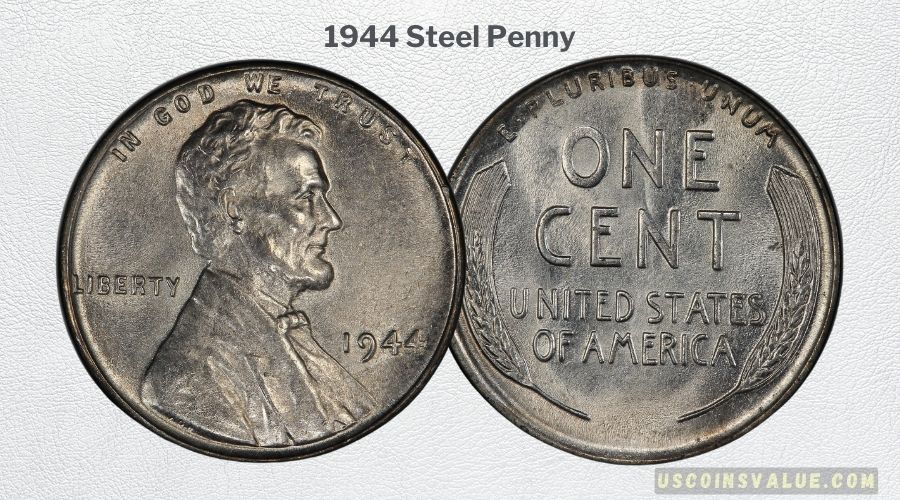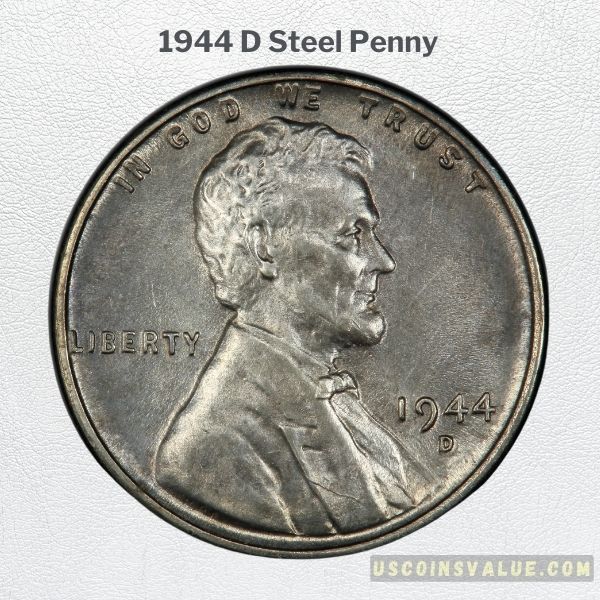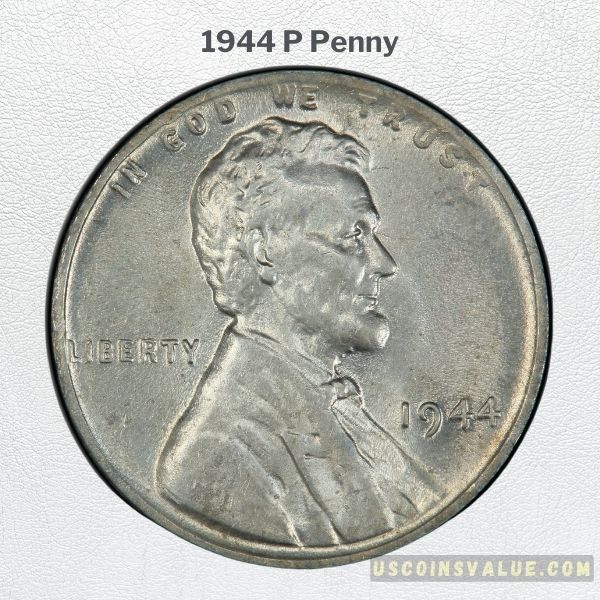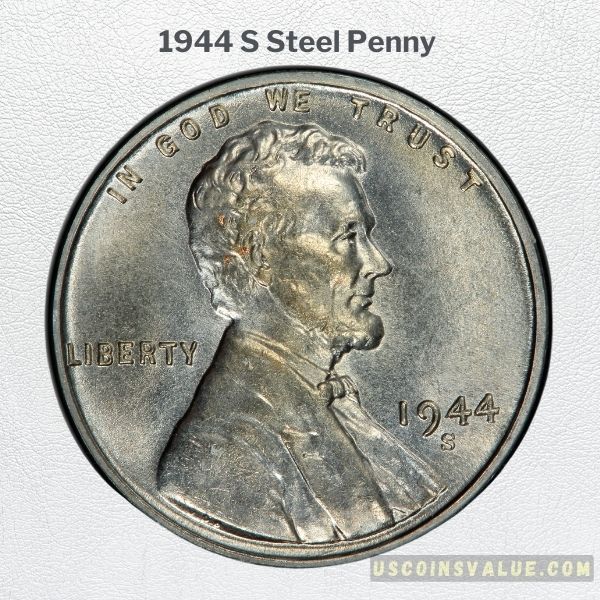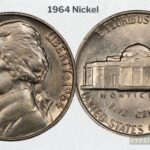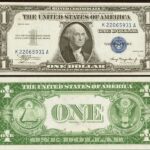The 1944 steel penny is the lesser-known relative of the 1943 copper penny, and like its predecessor, the 1944 steel cent is rare and worth more than $30,000 in the open market today.
In fact, the most expensive is the MS66 grade 1944 steel penny that sold for $408,000 at Heritage Auctions in 2021.
1944 and 1943 were the only years in the U.S. Mint’s history when pennies were made using zinc-coated steel planchets.
The value and rarity of these coins, including the 1944 steel penny, have to do with this unorthodox metal composition. Also, these coins are more celebrated and coveted since they were minted during World War II.
Read on to know why the 1944 steel penny was made out of a zinc-coated steel planchet and how World War II affected its mintage. Learn the history behind its existence and the various errors that make the coin even more valuable.
Background of the 1944 Steel Penny
The 1944 Steel Penny’s origin can be traced back to the turbulent years of World War II.
In 1942, the Lincoln wheat pennies were made with a composition of bronze – 95% copper and 5% tin & zinc. Copper, a critical wartime resource at the time, was in high demand for ammunition and other war equipment.
To conserve this precious metal, the United States government commissioned the U.S. Mint to experiment with alternative materials for coin production so that copper could be freed up for war efforts, a war the U.S. had then joined to fight against the Axis Powers of Germany, Italy, and Japan.
Zinc-Coated Steel Pennies Over Bronze Pennies – 1943
Experimental coins were made from 1941 to 1943 in an attempt to replace the bronze pennies. These experimental samples included stainless-steel experimental coins, tin alloy pennies, copper weld, aluminum, impregnated paper, zinc-coated steel, zinc alloy, amber glass, glass, plastic, and brass.
In 1943, the U.S. Mint finally settled on the zinc-coated steel for the new 1943 Lincoln wheat pennies, and since then, they have become known as the 1943 steel pennies due to their composition.
However, like many years, a transitional error (‘Struck on a Bronze Planchet’) happened where the previous year’s (1942) copper planchets (metal from which coins are made) remained in production and were used to make pennies that differed from the standard 1943 steel pennies.
These copper error coins were called the1943 copper pennies and have since become valuable due to their rarity. Some have sold for hundreds of thousands, including this 1943 ‘Struck on a Bronze Planchet‘ coin sold at a Heritage Auction in 2021 for $ 840,000.
Back to Bronze Pennies – 1944
In 1944, the U.S. Mint was forced to revert to the original bronze composition of 95% copper and 5% tin & zinc due to a couple of reasons.
Firstly, the 1943 steel pennies were not well-received by the public since they tended to rust quickly, which affected their appearance and durability. Also, the silvery finish of the steel pennies made it easier for people to confuse the 1943 steel pennies with nickels and dimes.
By 1944, the copper supply had improved due to wartime efforts to recycle and conserve copper resources.
As a result, the U.S. Mint decided to discontinue the production of steel pennies and resumed the minting of copper-tin pennies in 1944. This change marked the end of the steel-cent era, making the 1943 Steel Penny a unique and historically significant coin in American numismatics.
How 1944 Steel Pennies Were Made
Another transitional error (‘Struck on a Zinc-Coated Steel planchet’) happened during the transition from 1943 to 1944 pennies.
This mistake happened in the Denver and San Francisco Mint, where a few 1944 pennies were produced using the previous year’s steel penny planchets instead of the new bronze planchets.
In the Philadelphia Mint, a whole different issue occurred. Since the mint had a surplus collection of steel planchets from 1943, the U.S. Mint decided to put it to good use by producing coins for foreign governments.
In 1944, the zinc-coated steel planchets in the Philadelphia Mint were officially being used to strike 2-franc coins for Belgium.
During the production of these foreign coins, the zinc-coated planchets went astray and got mixed up with the 1944 penny dies, thereby leading to the creation of 1944 steel pennies that were struck on zinc-coated steel planchets using 1944 penny dies.
Therefore, 1944 steel pennies were made because of two errors: the use of 1943 zinc-coated steel planchets and the use of 2-franc Belgium coin planchets.
1944 Lincoln Steel Penny Features
1944 Steel Penny Specifications:
- Category: Lincoln Cents, Wheat Reverse (1909 – 1958)
- Year of Make: 1944
- Mint Branch: Denver (D), Philadelphia (P), San Francisco (S)
- Total Mintage: Less than 40 according to PCGS (real mintage is unknown)
- Face Value: $0.01
- Composition: 100% Zinc-coated steel
- Weight: 2.7 grams
- Diameter: 19 millimeters
- Thickness: 1.5 millimeters
- Edge: Smooth/Plain
Obverse and Reverse Design – What Does A 1944 Steel Penny Look Like?
The obverse (heads) features Abraham Lincoln’s bust image facing the left. It is the same image used since the 1909 Lincoln penny. Inscriptions include:
- IN GOD WE TRUST– at the top of the image
- LIBERTY – on the left of the image
- 1944– On the right of the image
- D, or S Mint Mark – appears below ‘1944’, denoting the mint facility where the coin was produced. Philadelphia (P) made coins do not have a mint mark ‘P.’
The reverse (tails) features the two wheat stalks on each side of the coin. Inscriptions include:
- E PLURIBUS UNUM – on the top side
- ONE CENT – at the top center
- UNITED STATES OF AMERICA – below ‘ONE CENT’
1944 Steel Penny Varieties
So, how many 1944 steel pennies were there?
There are only three varieties of the 1944 steel pennies:
- 1944 D steel pennies (with ‘D’ Mint Mark) – Made in Denver (D).
- 1944 P steel pennies (without mint mark)– Made in Philadelphia (P)
- 1944 S steel pennies (with ‘S’ mint mark) – Made in San Francisco (S)
The estimated mintage in each of the facilities is as follows:
- Denver: 7
- Philadelphia: 30
- San Francisco: 2
Only regular strike circulation coins were made in all the mints. Meaning there are no 1944 steel pennies in uncirculated Proof or Special Mint Set (SMS) varieties.
How Can I Tell If My 1944 Steel Penny Is Real?
Coins worth as much as the 1944 steel wheat penny are bound to have counterfeit siblings that are used to fool collectors and buyers. Knowing if your coin is genuine will go a long way in saving you money and ensuring the undeniable authenticity of your collectible.
Here is how to tell the 1944 steel wheat penny is real:
- Consult with a professional coin grading company – like PCGS or NGC to fully authenticate the coin. This is the safest and most assured way to know if your 1944 steel penny is genuine.
- Use a magnetic object – How do you know if your 1944 penny is steel? Simple: use a magnet. The 1944 Steel Wheat Penny is attracted to a magnet because of its steel composition. Copper pennies are not magnetic. You can use a small, strong magnet to check whether the coin is attracted to it. If the coin is not magnetic, it may be a fake.
- Silver Color – The silvery grey color of the penny is why some refer to it as a 1944 silver penny instead of a 1944 steel penny. If the coin doesn’t look silver, it is not a genuine 1944 steel cent.
- Check the Weight: Authentic 1944 Steel Wheat Pennies should weigh approximately 2.7 grams. If it significantly deviates from this weight, it may be a counterfeit.
- Verify the Design Features: Examine the obverse and reverse of the coin for design details consistent with the 1944 Steel Wheat Penny. Look for well-defined features, correct lettering, and correct positioning of elements.
- Compare to Known Genuine Examples: Compare the coin in question to known genuine 1944 Steel Wheat Pennies. This can help you identify any significant differences or irregularities that might indicate a fake. This article has a couple of linked examples to help you compare.
Why is the 1944 Steel Penny So Valuable?
The 1944 Steel pennies are highly valued because they are mint error coins from a mintage mistake of striking 1944 coins on zinc-coated steel planchets instead of bronze.
Standard 1944 Lincoln wheat pennies were made using bronze metal planchets of 95% copper and 5% tin & zinc. On the other hand, these special 1944 steel pennies were made using zinc-coated steel planchets.
The wrong planchet mistake led to the creation of less than forty 1944 steel pennies, making them rare and unique pieces highly coveted by the collectors’ market.
1944 Steel Wheat Penny Value
1944 steel penny has a face value of $0.01 and a melt value of $0.0006.
According to the NGC price guide, 1944 steel pennies are valued between $30,000 and $500,000 in today’s market.
Below is a summary value chart showcasing 1944 steel pennies and how they are valued:
| Grades | 1944-D | 1944-P | 1944-S |
| MS53 | $30,000 – $40,000 | $37,500 | N/A |
| MS54 | N/A | N/A | N/A |
| MS55 | $45,000 – $50,000 | $40,000 -$42,500 | N/A |
| MS56 | N/A | N/A | N/A |
| MS57 | N/A | N/A | N/A |
| MS58 | N/A | N/A | N/A |
| MS59 | N/A | N/A | N/A |
| MS60 | N/A | N/A | N/A |
| MS61 | $52,500 – 55,000 | $48,500 | N/A |
| MS62 | $62,500 – $70,000 | $55,000 | N/A |
| MS63 | $85,000 – $90,000 | $87,500 | N/A |
| MS64 | N/A | $185,000 | $55,000 |
| MS65 | N/A | N/A | N/A |
| MS66 | N/A | N/A | $475,000 – $500,000 |
Note:
- The N/A in columns without a price guide does not mean the coins are rare. Instead, it shows there needs to be more data or coins to publish an average price estimate.
1. 1944-D Steel Penny Value
According to the USA Coin Book, the 1944-D Lincoln wheat penny is worth $62,001 in uncirculated mint state MS(60) condition, while in about circulated condition AU950), the coin is valued at $46,688.
However, according to NGC, in 2023, the 1944 steel penny is valued between $30,000 and $50,000 in circulated condition. A pristine, uncirculated version of the coin is valued as high as $85,000.
MS63 is the highest recorded grade, with most pennies being older and worn out beyond the most basic mint state grades.
Below are the highest historical auction records for the 1944-D steel penny:
| Grade | Price | Firm | Sale Date |
| MS63 | $115,000 | Heritage Auctions | 2007 |
| MS63 | $92,000 | Heritage Auctions | 2008 |
| MS63 | $82,250 | Heritage Auctions | 2013 |
| MS63 | $79,313 | Heritage Auctions | 2013 |
| Au55 | $69,000 | Heritage Auctions | 2007 |
2. 1944-P Steel Penny (No Mint Mark) Value
According to the USA Coin Book, the 1944-P (without mint mark) Lincoln wheat penny is worth $58,491 in uncirculated mint state MS(60) condition, while in about circulated condition A.U. (50) the coin is valued at $34 803.
As of September 2023, the 1944-P steel wheat penny was valued between $35,000 and $ 43,500, according to the NGC price guide.
The highest recorded grade is the MS64; none higher have been found.
Below are the highest historical auction records for the 1944-P steel penny:
| Grade | Price | Firm | Sale Date |
| MS64 | $180,000 | Heritage Auctions | 2021 |
| MS64 | $158,625 | Stack’s Bowers | 2013 |
| MS64 | $108,000 | Heritage Auctions | 2021 |
| MS63 | $48,000 | Stack’s Bowers | 2018 |
| AU50 | $33,600 | Heritage Auctions | 2018 |
3. 1944-S Steel Penny Value
With a mintage of just two, this is the most expensive 1944 steel penny variety valued between $50,000 and $1,137,794, according to PCGS, NGC, and USA Coin Book.
According to the USA Coin Book, the 1944-S Lincoln wheat penny is worth $1,137,794 in a brilliant uncirculated Mint State MS(63), $759,524 in uncirculated Mint State MS(60) condition, and $564,655 in About Circulated condition A.U. (50).
The two graded 1944-S coins are in XF40 and MS66 grades only.
The MS66 coin, one of two, sold for $408,000 at a Heritage Auction in 2021 and holds the record of the highest-graded 1944 ‘Steelie’ penny from any mint.
The XF40/EF40, graded by NGC, sold for $49,200 in 2018 at Stalk’s Bowers.
Below are the highest historical auction records for the 1944-S steel penny variety:
| Grade | Price | Firm | Sale Date |
| MS66 | $408,000 | Heritage Auctions | 2021 |
| MS66 | $373,750 | Heritage Auctions | 2008 |
| XF40 | $49,200 | Stack’s Bowers | 2018 |
1944 Steel Penny Error List
Coin enthusiasts are often drawn to coins with errors since they add a layer of intrigue and rarity.
The 1944 Lincoln pennies made from a copper base had a wide range of errors that are considered rare and popular. These include:
- Double Denomination Planchet Struck Error
- Off-center strikes
- Double Die Obverse Error
- Die Chips
However, of all the recorded 1944 steel pennies, none have been registered with any major errors. The only mint error that has been recorded in this coin’s history is the ‘Struck Through Reverse Error’:
Strike-Through Reverse Error
This error was first noted on the reverse of an EF40-graded coin. The coin was presented at the Michigan State Numismatic Society show and proved that there were even rarer errors in the 1944 steel penny collection.
According to the description, the Strike Through Error was struck through grease when dies were being brought together with the planchet in between, thereby causing an impression on the tail’s side.
Conclusion
Please ensure you pay keen attention when looking for the 1944 steel pennies. Many of these coins in the market are fake because their high price tags make them a high target for counterfeits and forgeries that can easily fool a newbie.
eBay is a good marketplace for evaluating the value of your coin; however, there are better places to get a legitimate coin. For the most trusted coins, look for the 1944 steel pennies that trusted coin grading companies like NGC and PCGS have graded.

